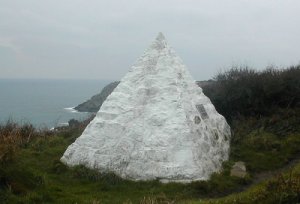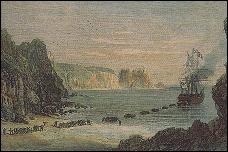
Eastern House, Porthcurno,
Penzance TR19 6JX
Tel: (01736) 810966
Email: info@pkporthcurno.com
Web: www.pkporthcurno.com
The end of the line
The cable that landed on Porthcurno ("PK") beach in 1870 was the start of a world-spanning telegraph system that stretched via the Mediterranean to Australia and the Far East. It was the brainchild of businessman and entrepreneur Sir John Pender, who had made a small fortune from the Atlantic cable of 1866. This was the start of the Eastern Telegraph Company's (E.T.C.) great network.
The first station, built in 1870, had a number of extensions over the years to accommodate the additional staff needed as the number of cables terminating at Porthcurno increased. In 1909 a new cable station was built to house the equipment, and the original station became the administrative offices and accommodation for the station staff. The station also trained operators for work overseas, and on completion of their training they would be despatched overseas at a salary of £52 per year. Increases were made on merit, and if an operator made too many errors while transmitting, his salary increase would not be paid.
Porthcurno Telegraph Museum is situated in a valley leading down to the sea, three miles from Land's End. The white pyramid which replaced a cliff-top hut marks where the submarine telegraph cable from Brest in France was terminated. Other cables were landed at Porthcurno until there were 14 linking Britain with her Empire and 'PK' became the largest cable station in the world.
Messages were sent in cable-code, a type of Morse which was sent by hand in the early years and received as flickering spots of light or wavering ink lines on paper tape.
The telegraph network was of strategic importance in wartime. Wireless signals could be intercepted but cables were secure from eavesdropping. During the First World War 43 soldiers were sent to guard against any enemy attack on the station, but no such incident occurred. Although security precautions were not taken before World War II was declared, immediately after 3rd September 1939 300 infantrymen arrived to protect the cable station. In World War II tunnels were blasted out of the granite hillside at Porthcurno and the station moved underground. In 1940 two hundred Cornish tin miners were employed to excavate two tunnels to house the equipment. In ten months of digging they removed 15,000 tons of rock, creating two tunnels, each 26 feet wide, 23 feet high and 150 feet long. It was opened for use on 31st May 1941 by the Cable & Wireless Chairman's wife, Lady Wilshaw. The station finally closed on the 31st December 1970 following a century of service. British cable-ships cut enemy cables in both world wars, which is how a German Atlantic cable was 'stolen' and diverted into Mousehole, and then Porthcurno.

In the 1980's David Kendall, Carpenter of the Cable & Wireless College, could see the 'end of an era' for the old cable telegraphy which had linked Britain with the world for so long. His foresight resulted in the saving of a unique collection of beautiful brass and mahogany instruments dating from the pioneering years of submarine telegraphy.
Britain's Empire-spanning Victorian cable network had a social, political and commercial significance equal to the development of the railways. Yet almost nothing remains except miles of rusting cables at the bottom of the oceans of the world - and this one collection at Porthcurno.
Much of the value of the collection lies in its completeness. Not only do we have early ink recorders, we still have stocks of glass siphons, the siphon grinding jigs, the beeswax and silken cords to mount them, the ink and paper slip. We not only have examples of submarine cables, but the cable-ship reports, cable repair kits, early cable charts, cable test sets, and more.
Porthcurno is part of the history of submarine cables. Many of the methods used to locate faults on cables had their origins in experiments made here in the last century. Three cables which still terminate in the museum demonstrate various earth currents, stray polarisation effects and other classic problems associated with fault location, while regenerator equipment developed by the E.T.C. in the 1920's to boost signals on long cables forms a chapter in the development of today's computerised digital networks.
On 9th June 1950 the Cable & Wireless Engineering School opened at Porthcurno. Here students completed the second half of an eighteen month course; later the whole course was taken here. In 1993 the school moved to Coventry and the building used was subsequently demolished. A relocated museum would lose the historic context of Porthcurno with its Victorian and wartime associations, and it was therefore important that the collection should remain at Porthcurno. This was supported by Cable & Wireless who still own the site and happily, the new tenants of Porthcurno did not require the use of the north tunnel. A feasibility study was commissioned by Cornwall County Council and it was agreed to try and keep the museum at Porthcurno and open it as an all-weather attraction for visitors. With the help of many volunteers, meetings were held and twenty ex-members of Cable & Wireless staff showed interest in preparing for public opening. The museum, which opened in May 1998, is housed in the former telegraph facility.

Porthcurno's association with international telecommunications links continues to the present day. The first successors to submarine telegraph cables were submarine telephony cables of coaxial construction, some of which were landed at Porthcurno. In the last twenty years or so these have all been superseded by their very high-capacity modern descendants, those using fibre optic technology as the transmission medium instead of copper. These also have been landed at Porthcurno forming a significant link, part of the UK connection to the international telecommunications 'backbone' infrastructure.
The potential educational value of the collection is wide. Unusual and memorable demonstrations of electricity and magnetism can reinforce Physical Science aims in the National Curriculum. Geographical and social aspects of life in Cornwall and on remote telegraph relay stations around the Empire will vividly illustrate aspects of Victorian life and the World War connections are also obvious. The collection is not just electrical equipment. There is a growing collection of handwritten logs, photographs and social history memorabilia of all kinds, including a scale model of a cable-ship made by the ship's engineer in off duty moments, and have been shown a diary kept by a wireless pioneer who once worked with Marconi. There is a small vintage wireless collection and some interesting associations with industrial espionage circa 1901!
For the future, we value support of all kinds. Donations of early wireless, telegraph or electrical equipment will be appreciated. Offers of practical help, from painting walls or signboards to conducting guided tours, clearing paths and doing historical research in the County library, are sought. For the electronic experts, there are vintage wireless receivers to be coaxed back into life. Properly financed and managed, the museum can fulfil three main functions as an unusual all-season attraction for visitors ("Cornwall's secret wartime underground communications centre"), a resource and curriculum enhancement opportunity for local schools and a reference collection for the serious researcher of electrical technology.
The early but very successful cable systems were eventually superseded by later wireless systems at Goonhilly Earth Satellite Station and Marconi's Radio Station on the Lizard Peninsula.
Facing down onto the main car park in the village.
Opening TimesApril - October Admission Charged |
Land's End Porthcurno St. Buryan The Minack Theatre Cornwall's History
Goonhilly Earth Satellite Station Marconi Visitors Centre